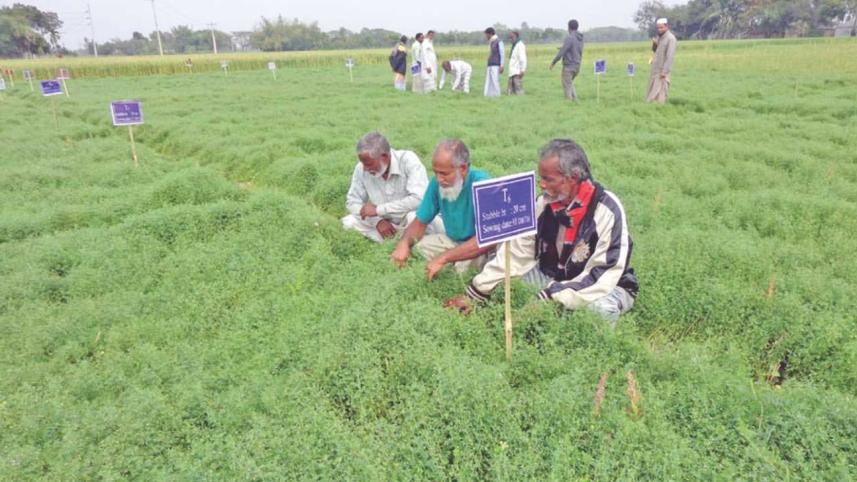Winter crop gains popularity among Pabna farmers

There is a rush of farmers to cultivate 'winter crop', which has a positive impact on the environment and is also more profitable. According to experts, the crop counters the bad effects of climate change. The winter crop planted at the paddy field just before harvesting as a 'relay-crop' enables farmers to produce as a very low cost of production.
"Farmers sow the seeds of the winter crop at their paddy fields just 8 to 10 days before harvest. Using the existing water at the paddy field, seeds grow within a few days." Dr. Md. Rabiul Alam, a senior scientific officer of Agriculture Research Institute, Pabna told the Daily Star. Through this method, farmers can use the fertility of the paddy field, said Alam, adding that the new method of cultivation was introduced to save the environment from climate change. "We have seen rapid extraction of 'Methane Gas' from the field due to excessive plough. If the cultivation stops once in a year that should keep from contamination," Dr. Alam said. Using rain water for growing seeds implies that there is no need to extract ground water.
Bangladesh Agriculture Research Institute (BARI) introduced the new methodology of cultivation for winter crops without plough field in 2012 as a test cultivation method. It became popular in the last two years. A total of 72 hectors of land in the two villages have been brought under relay crop cultivation in 2014, and this has reached 105 hectors this year, according to BARI, Pabna. "BARI introduced the method of cultivation keeping climate change in mind, but this also allows the farmers to earn extra profit," commented Dr. Shafikul Islam, Chief Scientific Officer of BARI, Pabna.

"I have cultivated wheat this year on 4 bigha land. Following this method, I have gotten bumper output!" said Md. AfzalHossain, a farmer of Baoikola village of Atghoriaupazila. He also informed that this method enables farmers to save 2 to 3 thousand taka in production costs. Furthermore, the method allows for greater yield compared to traditional cultivation methods. "I will be able to take my harvest to the market early so good price is available for the crop," he added.
Farmers of Baoikola village in Atghoriaupazila and Pushpopara village of PabnaSadarupazilahave been encouraged motivated to introduce the new method of cultivation to keep methane contamination at bay as well as to reduce dependency on ground water for cultivation. At the research areas of Baoikola village of Atghoriaupazila and Pushpopara village of PabnaSadarupazila, farmers are seen converting to winter crops using the new method of cultivation. Over a hundred farmers use this method in the area, according to BARI. Of the winter crops,wheat, corn, lentil (moshur andkheshari) andgarlic have been brought under beyond-plough cultivation.
Farmers are becoming interestedin adopting the method for the sake of economic benefit as well as for environmental reasons. BARI is working hard to popularize the method and spread its knowledge among farmers at large in other parts of the country as well. The researchers are working hand-in-hand with farmers towards the adoption of this method of cultivation.




 For all latest news, follow The Daily Star's Google News channel.
For all latest news, follow The Daily Star's Google News channel.
Comments